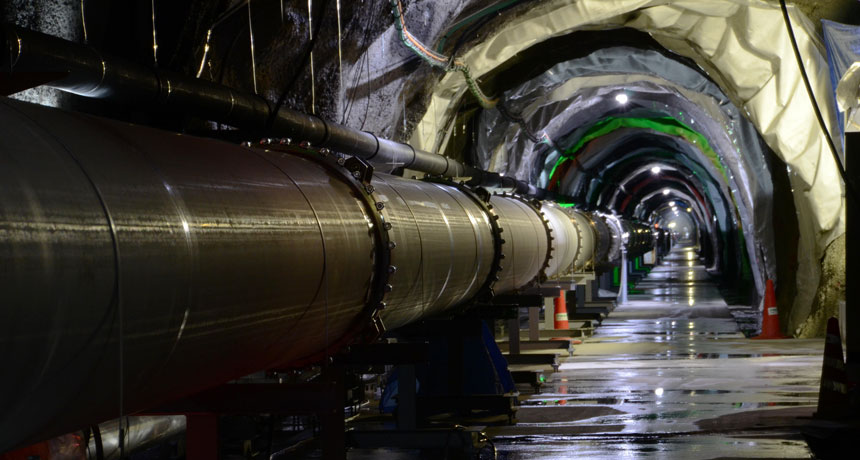
DEEP AND COLD Chilled mirrors and an underground hideout (shown) should help the KAGRA experiment in its upcoming search for gravitational waves.
ICRR, Univ. of Tokyo
- More than 2 years ago
In the quest for better gravitational wave detectors, scientists are going cold.
An up-and-coming detector called KAGRA aims to spot spacetime ripples by harnessing advanced technological twists: chilling key components to temperatures hovering just above absolute zero, and placing the ultrasensitive setup in an enormous underground cavern.
Scientists with KAGRA, located in Kamioka, Japan, now have results from their first ultrafrigid tests. Those experiments suggest that the detector should be ready to start searching for gravitational waves later in 2019, the team reports January 14 at arXiv.org.
The new detector will join similar observatories in the search for the minute cosmic undulations, which are stirred up by violent events like collisions of black holes. The Laser Interferometer Gravitational-Wave Observatory, LIGO, has two detectors located in Hanford, Wash., and Livingston, La. Another observatory, Virgo, is located near Pisa, Italy. Those detectors sit above ground, and don’t use the cooling technique, making KAGRA the first of its kind.
KAGRA consists of two 3-kilometer-long arms, arranged in an “L” shape. Within each arm, laser light bounces back and forth between two mirrors located at both ends. The light acts like a giant measuring stick, capturing tiny changes in the length of each arm, which can be caused by a passing gravitational wave stretching and squeezing spacetime.

In the new tests, performed in spring 2018, researchers cooled only one of KAGRA’s four mirrors, says KAGRA leader Takaaki Kajita of the University of Tokyo. When the detector starts up for real, the others will be chilled too.
Having the detector underground also helps keep the mirrors from vibrating due to activity on Earth’s surface. LIGO is so sensitive that it can be affected by rumbling trucks, a stiff breeze or even mischievous wildlife (SN Online: 4/18/18). KAGRA’s underground lair should be significantly quieter.
Building underground and going cold required years of effort from KAGRA’s researchers. “They’ve taken on these two great challenges, which are both important to the long-term future of the field,” says LIGO spokesperson David Shoemaker of MIT. In the future, even more advanced gravitational wave detectors could build on KAGRA’s techniques.
For now, adding KAGRA to the existing observatories should help scientists improve their studies of where gravitational wiggles come from. Once scientists detect a gravitational wave signal, they alert astronomers, who search for light from the cataclysm that generated the waves in the hope of better understanding the event (SN: 11/11/17, p. 6). Having an additional gravitational wave detector in a different part of the world will help better triangulate wave sources. “This feature is very important,” Kajita says, “because telescopes can only see a small part of the sky at a time.”
Editor’s note: A previous version of this story displayed a beam splitter instead of a cryogenic mirror. The story was updated on January 21, 2019, to correct the image.







